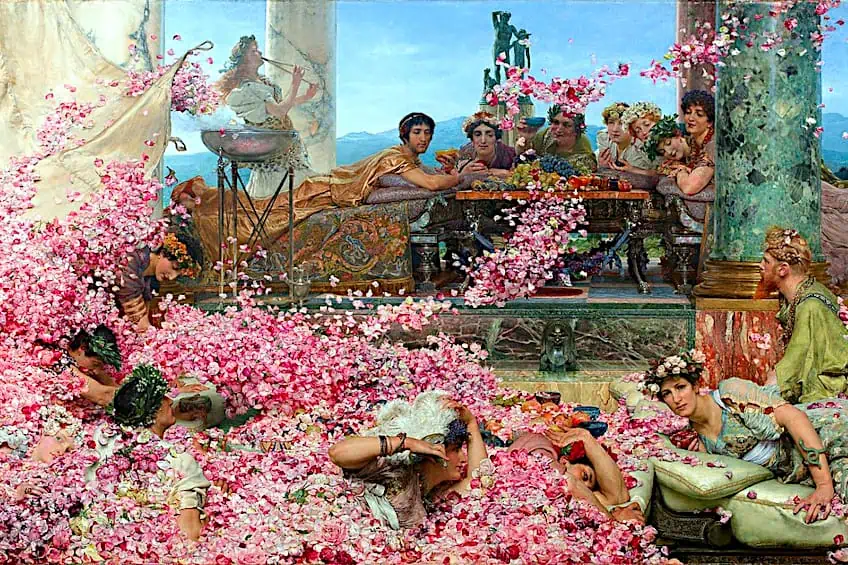Famous Victorian Paintings – 19th Century Blockbusters
Victorian art was a period marked by the changes that took place in Great Britain from about 1840 to 1900, a time of industrial development and therefore, social, and political change within the nation. During this time, we see more mysticism, fantasy, and romanticism brought into the Victorian culture and social ideals. In the following article, we will discuss what Victorian paintings are and the history behind them, as well as list 10 of the most famous Victorian artworks.
Contents
- 1 What Are Victorian Paintings?
- 2 10 Famous Victorian Paintings
- 2.1 Christ in the House of His Parents (‘The Carpenter’s Shop’) (1849 – 1850) by John Everett Millais
- 2.2 Ophelia (1852) by John Everett Millais
- 2.3 The Scapegoat (1856) by William Holman Hunt
- 2.4 Proserpine (1874) by Dante Gabriel Rossetti
- 2.5 The Lady of Shalott (1888) by John William Waterhouse
- 2.6 The Roses of Heliogabalus (1888) by Sir Lawrence Alma-Tadema
- 2.7 Lady Agnew of Lochnaw (1892) by John Singer Sargent
- 2.8 Flaming June (1895) by Frederic Leighton
- 2.9 God Speed (1900) by Edmund Leighton
- 2.10 Midsummer Eve (1908) by Edward Robert Hughes
- 3 Frequently Asked Questions
What Are Victorian Paintings?
Victorian art refers to a period of styles or art movements that occurred during the reign of Queen Victoria (1837–1901) in the United Kingdom. These movements include Classicism, Neoclassicism, Romanticism, and Impressionism, each with its own style. The most popular subject matter was history painting, genre painting, landscapes, and portraits, most of which revealed its time’s Imperial and Christian beliefs. Fairies and symbolism were a common theme in Victorian era art, with the feminine as a major element, as were scenes from Shakespeare’s plays and the Arthurian Legends.
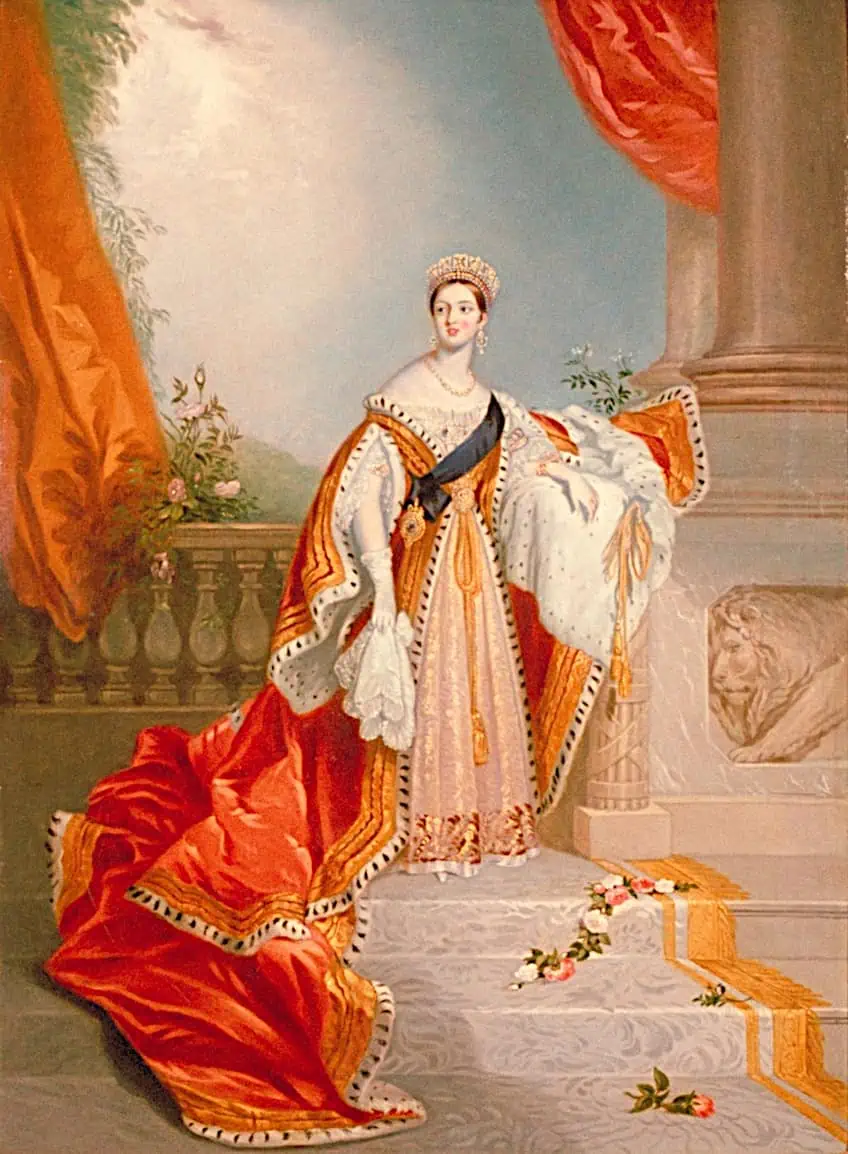
In the early Victorian era, the theories of Joshua Reynolds, the Royal Academy of Art’s first president dictated Victorian artworks. He was majorly influenced by the Italian Renaissance artist, Raphael and believed that it was the artist who idealized the subject they painted and made them look impressive. This approach encouraged artists to depict their subjects not true to form but in a more poetic way. This would be the case considering that nobility, historical and military scenes were subjects that dominated at this time. By the time Victoria became queen, the wealthy middle class was rising, and this changed the art market, making the previous approach to be considered outdated.
During the industrial age, artists turned to accuracy and paid more attention to detail, depicting the world as it was. From this emerged the Pre-Raphaelite Brotherhood in 1848. They were a group of young artists started by Dante Gabriel Rossetti, William Holman Hunt, and John Everett Millais who came together mainly as a reaction against the Royal Academy, and they painted from nature as often as they could.

Even if an artist painted a scene from imagination or fantasy, the picture was always painted with as much realism as possible. They emphasized the importance of symbolism, iconography, and subject matter. The group did not last long, dissolving by 1854, but their ideas are still influential to this day. Often noted for its realism, by the end of the century, the Victorian age was taken over by the coming of modernization and the rise of abstract art.
10 Famous Victorian Paintings
There are many beautiful famous Victorian paintings, but since we cannot list them all we have listed 10 of the most famous Victorian artworks below, such as portraits, religious and historical scenes, fantasy, and other subjects.
Christ in the House of His Parents (‘The Carpenter’s Shop’) (1849 – 1850) by John Everett Millais
| Artist | John Everett Millais (1829 – 1896) |
| Date Completed | 1849 – 1850 |
| Dimensions (cm) | 86.4 x 139.7 |
| Medium | Oil on canvas |
| Where It Is Currently Housed | Tate Britain, London, United Kingdom |
Christ in the House of His Parents (1849 – 1850) was one the first important paintings about religion by the English artist John Everett Millais. It depicts Christ as a young boy in the carpenter’s shop as he holds his hand up for the carpenter to see the wound in his palm. The painting was at first met with great criticism and horror by the public, and the Times protested the way in which the Holy family had been depicted as lowly, common people in a carpenter’s shop.

The painting is executed with meticulous attention to detail, the artist based the scene on a carpenter’s shop that existed on Oxford Street.
There are many Christian symbols in the picture, such as the triangle on the wall, referring to the Holy Trinity, and the wood and nails that strongly reference the crucifixion together with the wound on the boy’s hand which he cut on a nail in the shop. The young boy to the right of the composition represents St John fetching a bowl of water to wash the wound. A white dove, symbolic of the Holy Spirit is perched on a ladder in the back.
Ophelia (1852) by John Everett Millais
| Artist | John Everett Millais (1829 – 1896) |
| Date Completed | 1852 |
| Dimensions (cm) | 76 x 112 |
| Medium | Oil on canvas |
| Where It Is Currently Housed | Tate Britain, London, United Kingdom |
Ophelia (1852) is one of the most famous Victorian paintings and depicts a scene from William Shakespeare’s famous play, Hamlet Act IV Scene VII, in which Ophelia drowns in a stream. In the story, she is driven mad when Hamlet, her lover, murders her father, leading her to fall into the water and meet her end. Victorian painters loved Shakespeare, who was often a source of inspiration in their work and the romantic tragedy of Ophelia was a common subject.
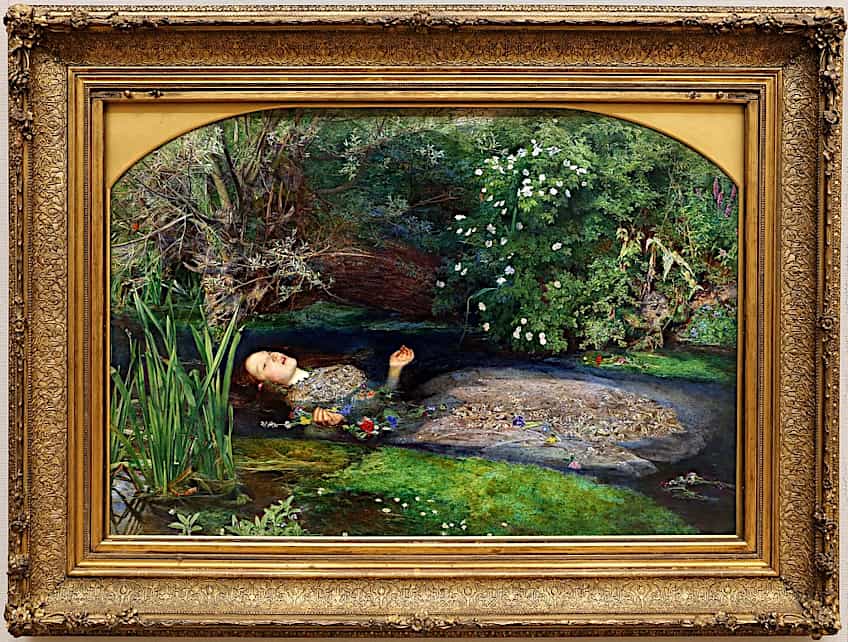
The background of the work was painted in Surrey with a close study of nature while the figure was painted later. The model used to pose as Ophelia was a Pre-Raphaelite favorite, Elizabeth Siddal who went on to marry Rossetti, another artist of the Brotherhood. To complete the painting, she had to pose in a bath of water that was kept warm by lamps underneath the tub for a period of four months. Siddal caught a bad cold after the lamps went out at one point.
The plants in the painting were depicted with great attention to detail, most of which have some symbolic meaning. The roses that are seen near her check and on the riverbank may refer to Ophelia’s brother calling her the “rose of May”. While pansies are symbolic of love in vain, and the daisy, nettle, and willow may relate to pain, innocence, and abandoned love. The poppy symbolizes death.
The Scapegoat (1856) by William Holman Hunt
| Artist | William Holman Hunt (1827 – 1910) |
| Date Completed | 1856 |
| Dimensions (cm) | 86 x 140 |
| Medium | Oil on canvas |
| Where It Is Currently Housed | Lady Lever Art Gallery, Port Sunlight, United Kingdom |
The Scapegoat (1856) was painted by the English artist William Holman Hunt, and depicts a goat with a red cloth wrapped around its horns as it stands somewhat unsteadily against a backdrop of mountains and water. It represents the “scapegoat” from the Book of Leviticus from the Torah and Old Testament. On the Day of Atonement, a goat would traditionally be sent out with a piece of red cloth wrapped around its horns, representing human sin. The painting was very significant for Hunt. After battling a religious dilemma, he journeyed to the Holy Land where he started painting this scene.

Hunt began working on the painting on the Red Sea shore and finished the piece in his London studio. There are two versions of The Scapegoat, a smaller more colorful one with a rainbow and a dark-haired goat, and the larger version featured here with a goat that has a lighter coat. The scene we see in the painting is in Sodom, located on the edge of the Dead Sea, while Edom’s mountains line the background.
Proserpine (1874) by Dante Gabriel Rossetti
| Artist | Dante Gabriel Rossetti (1828 – 1882) |
| Date Completed | 1874 |
| Dimensions (cm) | 125.1 x 61 |
| Medium | Oil on canvas |
| Where It Is Currently Housed | Tate Britain, London, United Kingdom |
The English artist, Dante Gabriel Rossetti painted eight different versions of Proserpine (1874) before completing the last version in the same year that he died in 1822. The version we have chosen for this article is the seventh one which was commissioned by Frederick Richards Leyland. The painting represents Proserpina, the Greek goddess that resides in the Underworld during the Winter season. In mythology, Proserpine was the daughter of Ceres who was taken away to the Underworld by Hades and married her. Ceres begged Zeus to return Proserpine to Earth and he agreed if she had not eaten any of the fruits in the Underworld. However, she had consumed six pomegranate seeds, and therefore, for six months of the year was forced to stay in the Underworld.

Proserpine is painted in the artist’s Pre-Raphaelite style. The goddess is draped in a rich blue dress that shimmers in the dim light of the scene. The atmosphere overall is quite dark, except for the light cast on the figure, showing the gloominess of Proserpine’s home in the Underworld. She holds in her left hand a pomegranate that has been bitten into, the reason for her six-month captivity. The pomegranate may be a symbol of marriage and the incense burner signifies the goddess, while the ivy spray represents the grip of memory.
It is interesting to note that the model for this work and many others by Rossetti was Jane Morris. She was the wife of William Morris and regarded as the muse of the Pre-Raphaelite Brotherhood. Her own life bears a resemblance to that of a captive beauty – Her husband was very cold, and she had a long intimate relationship with Rossetti. An accomplished designer and embroiderer, she was a pioneer of the Arts and crafts Movement.
The Lady of Shalott (1888) by John William Waterhouse
| Artist | John William Waterhouse (1849 – 1917) |
| Date Completed | 1888 |
| Dimensions (cm) | 153 x 200 |
| Medium | Oil on canvas |
| Where It Is Currently Housed | Tate Britain, London, United Kingdom |
The Lady of Shalott (1888) is one of the most famous Victorian Gothic paintings by the English painter, John William Waterhouse depicting a scene from a poem from 1832 by Alfred, Lord Tennyson which holds the same title as the painting. In the poem, the Lady of Shalott is banned with a curse of death should she look out of the window of a castle in which she lives in on a river that leads to Camelot. To see the images of the outside world she must look at the reflections in a mirror. One day she sees the knight, Lancelot reflected in the mirror and falls in love. She then breaks her ban by looking through the window straight at him. Wishing to meet him, she gets onto a boat and leaves the castle, dying before she reaches Camelot’s shore.
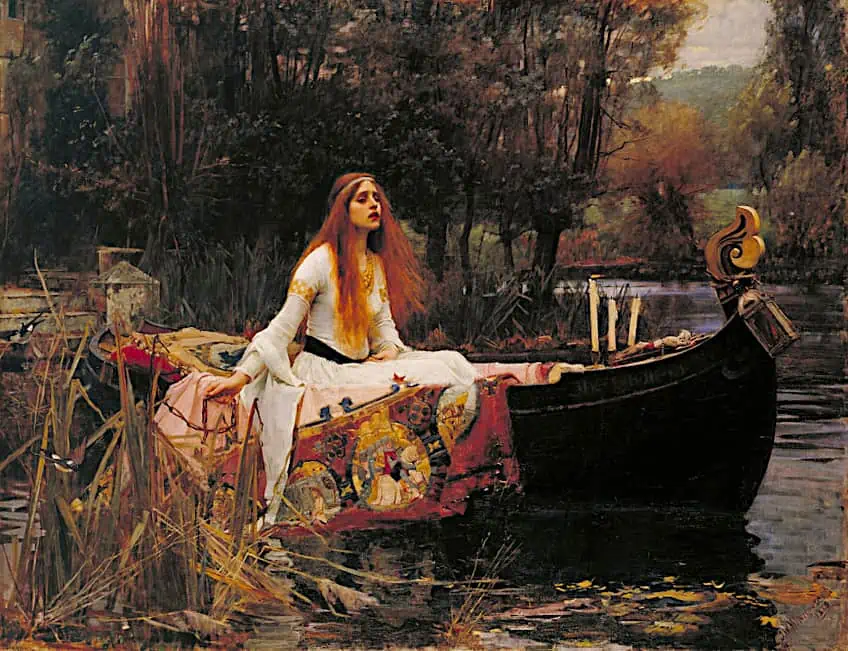
In this painting, Waterhouse has implemented a very similar style to that of the Pre-Raphaelite Brotherhood, with its vivid color usage and fine detail, even though the Brotherhood separated when he was a young boy.
The scene is realistically painted with the Lady of Shalott depicted as sitting on a large piece of fabric that she has woven herself, with a cross laying towards the stern and a lamp attached to the bow of the boat. Three candles are seen next to the cross, symbolizing life. One candle remains lit while the other two have already burned out, suggesting her imminent fate. Her light dress contrasts with the darker background, perhaps indicating her innocence. The longing expression on her face lures the viewer into her wistful moment of courage.
The Roses of Heliogabalus (1888) by Sir Lawrence Alma-Tadema
| Artist | Sir Lawrence Alma-Tadema (1836 – 1912) |
| Date Completed | 1888 |
| Dimensions (cm) | 132 x 214 |
| Medium | Oil on canvas |
| Where It Is Currently Housed | Private Collection |
The notorious party hosted by the Roman Emperor Heliogabalus, with its languor, lust, and gluttony is depicted in The Roses of Heliogabalus (1888) by the Dutch artist Sir Lawrence Alma-Tadema. Academic paintings were popular during the Victorian era and often used juicy historical tales for their subjects. And although the Victorians are often considered stuffy and formal, and covered in dark velvet, late Victorian paintings were sometimes void of moralizing themes and dressed in soft silks.

In the painting, the emperor is lying leisurely on a bed on a stage as he observes the dinner party he has thrown as his guests are showered in pink rose petals. According to the story, Heliogabalus smothered his guests with flowers that fell from a fake ceiling, causing some of them to suffocate to death. In the background, a woman stands wearing a leopard hide while playing the double pipes. In front of her and behind the emperor’s entourage is a bronze sculpture of Dionysus, the nature god of ecstasy and wine, based on the Ludovisi Dionysus from the second century AD.
Lady Agnew of Lochnaw (1892) by John Singer Sargent
| Artist | John Singer Sargent (1856 – 1925) |
| Date Completed | 1892 |
| Dimensions (cm) | 127 x 101 |
| Medium | Oil on canvas |
| Where It Is Currently Housed | Scottish National Gallery, Edinburgh, Scotland |
The Lady Agnew of Lochnaw (1892), painted by the American expatriate John Singer Sargent, was special for its time because of the model’s confident direct gaze at the viewer, which was uncommon for contemporary portraiture. Lady Agnew, born with the name Gertrude Vernon (1864 – 1932) was made a celebrity figure in high society when this painting was successfully received at its exhibition in 1893 at the Royal Academy in London. This reception also helped to secure Sargent’s reputation as an artist in England.
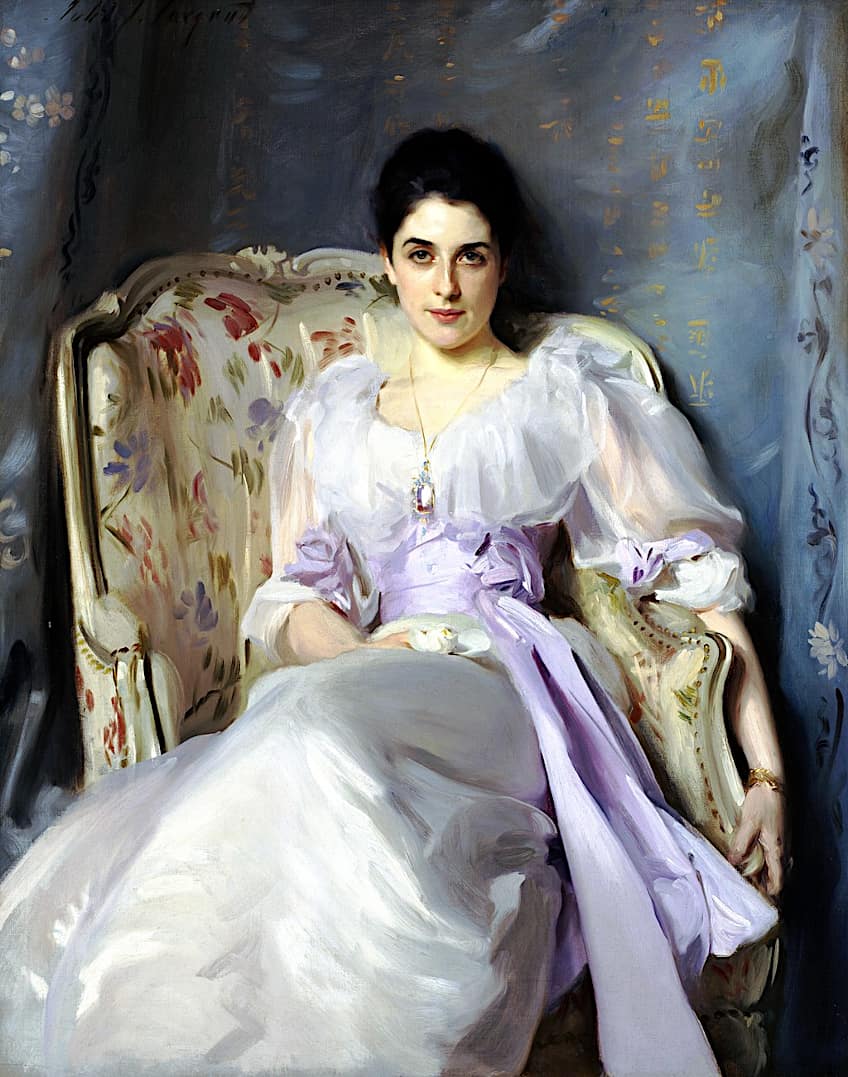
The painting has a fluid feel to it, with its sweeping brushstrokes and soft color palette. Lady Agnew tilts back as she sits in a French 18th-century chair, her posture relaxed and poised as her right-hand lies in her lap and her left arm hangs over the side of the chair, clutching it. She is dressed in a white dress with a lavender-colored silk sash wrapped around her waist, while the backdrop is blue Chinese silk.
It is believed that she may have been recovering from the flu during the sittings, which may explain her slack posture, however, she makes it look very graceful.
Flaming June (1895) by Frederic Leighton
| Artist | Frederic Leighton (1830 – 1896) |
| Date Completed | 1895 |
| Dimensions (cm) | 120 x 120 |
| Medium | Oil on canvas |
| Where It Is Currently Housed | Museo de Arte de Ponce, Ponce, Puerto Rico |
Flaming June (1895) is often considered a masterpiece by the British artist, Frederic Leighton. It depicts a woman half curled up on a low couch or bench with her head resting on her left arm. The pose of a tired model apparently inspired the composition of this painting, which was portrayed by Leighton in a more elaborate graceful way while also adding thin orange fabric. It is thought that the figure may also be linked to the sleeping nymphs often carved by the Greeks and partly based on Michelangelo’s sculpture, Night (1531). Considering that Leighton leaned into the classicist art style, this may be true.

The perspective in Flaming June is exceptional – Leighton drew up many sketches of the figure and four drafts before arriving at a final decision. The figure’s sinuous posture, the realistic manner in which she is rendered, the rich color of the fabric, and the marble backdrop are what make this picture remarkable.
God Speed (1900) by Edmund Leighton
| Artist | Edmund Leighton (1852 – 1922) |
| Date Completed | 1900 |
| Dimensions (cm) | 160 x 116 |
| Medium | Oil on canvas |
| Where It Is Currently Housed | Private Collection |
This painting of an armored knight saying farewell to his beloved as he leaves for war is by the English painter, Edmund Leighton and is entitled, God Speed (1900). It was the first of many works by the artist on the topic of chivalry and was exhibited at the Royal Academy of Arts in the same year it was completed.

God Speed is a Medieval-themed fantasy. Leighton specialized in historical genre painting, especially regency and medieval subjects. The knight is sitting on a white horse as he follows the other knights in front of him through a gateway and stops in front of a young woman standing on a stone staircase. She wraps a red sash around the knight’s arm which he must return. This is a medieval custom done in the hopes that the knight will return alive and well and the two people will be reunited. On the newel post of the stairs sits a statue of a griffin, which is a symbol of military strength and courage.
Midsummer Eve (1908) by Edward Robert Hughes
| Artist | Edward Robert Hughes (1851 – 1914) |
| Date Completed | 1908 |
| Dimensions (cm) | 88 x 119 |
| Medium | Watercolor |
| Where It Is Currently Housed | The Maas Gallery, London, United Kingdom |
The British artist, Edward Robert Hughes began as an artist of the Pre-Raphaelite Brotherhood and painted mostly watercolors. Midsummer Eve (1908) is an example of his perfectionism and his interest in symbolism. The work is reminiscent of William Shakespeare’s play, Midsummer Night’s Dream (1600) as the female figure stands in the middle of what seems to be a forest, encircled by fairies.

Enchanted by what she sees, the woman’s skin glows from the magical light emitted by the creatures below her. She does not seem surprised to see them there but is rather enthralled. The night of Midsummer’s Eve is the shortest of the year and is historically a powerful time for young women to manifest their beloved. Some ladies dance around fires and even cast spells. This time of the year explains that, although it is late in the evening, the atmosphere in the picture is not too dark.
And that concludes our exploration of Victorian era paintings. During a time when England was facing many changes in the process of reshaping itself, Victorian art showed the dreams of its people through fantasy, color, and symbolism. If you have been inspired by this article, we encourage you to further your journey into the topic of Victorian era paintings and Victorian gothic paintings.
Frequently Asked Questions
What Is the Most Popular Subject Matter in Victorian Era Paintings?
The most popular subject matter in Victorian art was history painting, genre painting, landscapes, and portraits, most of which revealed its time’s Imperial and Christian beliefs. Myth, symbolism, and folklore were also popular subjects, with fairies and women featuring often.
Who Are Famous Victorian Painters?
Some of the most well-known painters of Victorian era art are William Holman Hunt, Dante Gabriel Rossetti, John Everett Millais, John William Waterhouse, Frederic Leighton, and Edward Robert Hughes.
What Style Is Victorian Painting?
Victorian-era paintings cover a period of styles or art movements that occurred during the reign of Queen Victoria (1837–1901) in the United Kingdom. These movements include Classicism, Neoclassicism, Romanticism, and Impressionism, each with its own style. In essence, the art created during this time of change in England showed the dreams of its people through fantasy, color, and symbolism, as well as painstaking attention to detail.
Jaycene-Fay Ravenscroft is a writer, poet, and creative based in South Africa, boasting over 6 years of experience working in a contemporary art gallery. She earned her Bachelor of Arts degree with majors in Art History and Ancient History from the University of South Africa, supplementing her studies with courses in Archaeology and Anthropology. Driven by a passion for learning, Jaycene-Fay finds inspiration in symbology and the interconnectedness of the world. Trained to analyze and critique art, she is enthusiastic about delving into the meanings behind each artwork, exploring its ties to the artist’s cultural, historical, and social context. Writing serves as Jaycene-Fay’s means of researching, sharing knowledge, and creatively expressing herself. For artfilemagazine, Jaycene-Fay writes articles on art history with a focus on historical paintings.
Learn more about Jaycene-Fay Ravenscroft and about us.
Cite this Article
Jaycene Fay, Ravenscroft, “Famous Victorian Paintings – 19th Century Blockbusters.” artfilemagazine – Your Online Art Source. March 17, 2023. URL: https://artfilemagazine.com/famous-victorian-paintings/
Ravenscroft, J. (2023, 17 March). Famous Victorian Paintings – 19th Century Blockbusters. artfilemagazine – Your Online Art Source. https://artfilemagazine.com/famous-victorian-paintings/
Ravenscroft, Jaycene Fay. “Famous Victorian Paintings – 19th Century Blockbusters.” artfilemagazine – Your Online Art Source, March 17, 2023. https://artfilemagazine.com/famous-victorian-paintings/.


